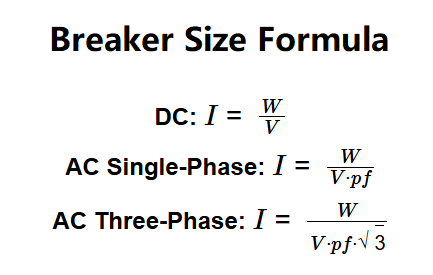1. What is Breaker Size Calculator?
Definition: This calculator determines the appropriate breaker size for a circuit by calculating the total current based on the power, voltage, and circuit type, then applying a safety margin and recommending the closest standard breaker size.
Purpose: It is used in electrical engineering to ensure circuit breakers are properly sized to handle the load safely without tripping under normal operation or allowing unsafe overheating.
2. How Does the Calculator Work?
The calculator uses the following formulas to calculate the current (\( I \)):
DC: \( I = \frac{W}{V} \)
AC Single-Phase: \( I = \frac{W}{V \cdot pf} \)
AC Three-Phase: \( I = \frac{W}{V \cdot pf \cdot \sqrt{3}} \)
The breaker size is then calculated as 125% of the current: \( \text{Calculated Breaker Size} = I \times 1.25 \). The closest standard breaker size that meets or exceeds this value is recommended.
Where:
- \( I \): Current (A)
- \( W \): Total power (W)
- \( V \): Voltage (V)
- \( pf \): Power factor (for AC circuits, between 0 and 1)
- \( \sqrt{3} \): Constant for three-phase systems (approximately 1.732)
Steps:
- Select the circuit type (DC, AC single-phase, or AC three-phase).
- Enter the total power (\( W \)) with its unit (W, kW).
- Enter the voltage (\( V \)) with its unit (V, mV, kV).
- For AC circuits, enter the power factor (\( pf \)).
- Convert inputs to base units (W, V).
- Calculate the current using the appropriate formula.
- Calculate the breaker size by applying the 125% safety margin.
- Recommend the closest standard breaker size from the list: 15, 20, 25, 30, 40, 50, 60, 70, 80, 90, 100, 125, 150, 200 A.
- Convert each result to the selected output unit (A, mA, µA, kA).
- Display the results with 2 decimal places.
3. Importance of Breaker Size Calculation
Calculating the correct breaker size is crucial for:
- Safety: Preventing overheating and electrical fires by ensuring the breaker trips before the circuit becomes overloaded.
- Reliability: Avoiding nuisance tripping under normal operation by providing a 25% safety margin.
- Compliance: Meeting electrical codes and standards for circuit protection by using standard breaker sizes.
4. Using the Calculator
Example: An AC single-phase circuit with a total power of 5000 W, a voltage of 120 V, and a power factor of 0.9:
- Circuit Type: AC Single-Phase
- Total Power (\( W \)): 5000 W
- Voltage (\( V \)): 120 V
- Power Factor (\( pf \)): 0.9
- Current (\( I \)): \( \frac{5000}{120 \times 0.9} = 46.30 \) A
- Calculated Breaker Size: \( 46.30 \times 1.25 = 57.87 \) A
- Closest Standard Breaker Size: 60 A
- Result (in A): Total Load = 46.30 A, Calculated Breaker Size = 57.87 A, Closest Standard Breaker Size = 60 A
- Result (in mA): Total Load = 46300.00 mA, Calculated Breaker Size = 57870.00 mA, Closest Standard Breaker Size = 60000.00 mA
5. Frequently Asked Questions (FAQ)
Q: Why is the breaker sized at 125% of the load?
A: The 125% rule provides a safety margin to prevent overheating while ensuring the breaker doesn’t trip under normal operation.
Q: What is the power factor in AC circuits?
A: The power factor (\( pf \)) is the ratio of real power to apparent power, typically between 0 and 1. It accounts for the efficiency of power usage in AC circuits.
Q: Why use standard breaker sizes?
A: Standard breaker sizes (e.g., 15, 20, 30 A) are commonly available and meet electrical code requirements, ensuring compatibility and safety.
Breaker Size Calculator© - All Rights Reserved 2025
 Home
Home
 Back
Back
